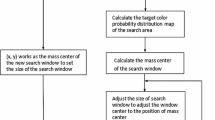Abstract
Video cameras play an important role in achieving the potentials promised by Intelligent Transportation Systems. In particular, video tracking systems have been widely applied in traffic flow data collection and incident detection by tracking and analyzing vehicle trajectories through video image processing. Focusing on current vehicle tracking methods that are limited to complex traffic scenes such as target non-uniqueness and color distraction in real traffic situations, this paper proposes an improved Continuously Adaptive Mean Shift (CAMShift) method for automatic multi-vehicle tracking using video cameras. The proposed method firstly uses a background subtraction method for automatically detecting, selecting, and initializing targets, i.e., vehicles. Moreover, a motion estimation method is proposed for estimating vehicle motion states and predicting the new locations of the vehicles. Finally, both the color and edge feature distributions of the vehicles are extracted and a mixed model is established for searching the matching vehicles in the next image frame. The proposed method was comparatively evaluated with the traditional CAMShift method using the same video sequences captured from real traffic situations. Evaluation results showed that the proposed method is efficient for accurately tracking vehicle movements, and is promising for practical applications.
Similar content being viewed by others
References
Allen, J. G., Xu, Y. D., and Jin, J. S. (2006). “Object tracking using CAMShift algorithm and multiple quantized feature spaces.” In: Proceedings of the Pan-Sydney Area Workshop on Visual Information Processing, Sydney, Vol. 36, pp. 3–7.
Atkociunas, E., Blake, R., Juozapavicius, A., and Kazimianec, M. (2005). “Image processing in road traffic analysis.” Nonlinear Analysis: Modeling and Control, Vol. 10, Issue 4, pp. 315–332.
Beymer, D. and Malik, J. (1996). “Tracking vehicles in congested traffic.” Proceedings of the 1996 IEEE, Intelligent Vehicles Symposium, IEEE, pp. 130–135.
Birchfield, S. and Rangarajan, S. (2005). “Spatiograms versus histograms for region-based tracking.” In: Proceedings of the 2005 IEEE Computer Society Conference on Computer Vision and Pattern Recognition, San Diego, USA, Vol. 2, pp. 1158–1163.
Bradski, G. (1998). “Computer vision face tracking for use in a perceptual user interface.” Intel Technology Journal, Vol. 2, Issue 2, pp. 12–21.
Chachich, A., Pau, A., and Barber, A. (1997). “Traffic sensor using a color vision method.” International Society for Optics and Photonics, Photonics East’96, pp. 156–165.
Cheng, Y. (1995). “Mean shift, mode seeking, clustering.” IEEE Transactions on Pattern Analysis and Machine Intelligence, Vol. 17, Issue 8, pp.790–799.
Collins, R., Lipton, A., Kanade, T., Fujiyoshi, H., Duggins, D., Tsin, Y., and Wixson, L. (2000). A system for video surveillance and monitoring. VSAM Report, No. CMU-RI-TR-00-12, The Robotics Institute, Carnegie Mellon University, Pittsburgh, PA, USA.
Collins, R. T. and Liu, Y., and Leordeanu, M. (2005). “On-Line selection of discriminative tracking features.” IEEE Transactions on Pattern Analysis and Machine Intelligence, Vol. 27, Issue 10, pp. 1631–1643.
Comaniciu, D. and Meer, P. (1997) “Robust analysis of feature spaces: Color image segmentation.” Proceedings of 1997 IEEE Conference on Computer Vision and Pattern Recognition, San Juan, Puetro Rico, pp. 750–755.
Comaniciu, D., Ramesh, V., and Meer, P. (2004). “Kernel-based object tracking.” IEEE Transactions on Pattern Analysis and Machine Intelligence, Vol. 26, Issue 3, pp. 397–402.
Gonzalez, R. and Woods, R. (2005). Digital image processing using MATLAB, Electronic Industry Press, Beijing, China.
Lou, J. G., Tan, T. L., and Hu, W. (2006). “3-D model-based vehicle tracking.” IEEE Transactions on Image Processing, Vol. 14, Issue 10, pp. 1561–1569.
Nikos, P. and Deriche, R. (2000). “Geodesic active contours and level sets for the detection and tracking of moving objects.” IEEE Transactions on Pattern Analysis and Machine Intelligence, Vol. 22, Issue 3, pp. 266–277.
Otsu, N. (1979). “A threshold selection method from gray-level histograms.” IEEE Transactions on Systems, Man, and Cybernetics, Vol. 9, Issue 1, pp. 62–66.
Qi, Y., Tang, Y., and Smith B. L. (2006). “Video-based automated identification of freeway shoulder events.” Transportation Research Record: Journal of the Transportation Research Board, Transportation Research Board of the National Academies, Vol. 1972, pp. 46–53.
Schonfeld, D. and Goutsias, J. (1991). “Optimal morphological pattern restoration from noisy binary images.” IEEE Transactions on Pattern Analysis Machine Intelligence, Vol. 13, Issue 1, pp. 14–29.
Shapiro L. and Stockman, G. (2005). Computer vision, China Machine Press, Beijing, China.
Surenda, G. and Osama, M. (2002). “Detection and classification of vehicles.” IEEE Transaction on Intelligent Transportation Systems, Vol. 3, Issue 1, pp. 37–47.
Tissainayagam, P. and Suter, D. (2005). “Object tracking in image sequences using point features.” Pattern Recognition, Vol. 38, Issue 1, pp. 105–113.
Wang, X, Wang, J., and Tian, M. (2008). “Mean shift tracking algorithm based on spatial edge orientation histogram.” Journal of Image and Graphics, Vol. 13, Issue 3, pp. 586–592 (in Chinese).
Wang, Z., Yang, X., Xu, Y., and Yu, S. (2009). “CAMShift guided particle filter for visual tracking.” Pattern Recognition Letters, Vol. 30, Issue 4, pp. 407–413.
Xia, J., Rao, W., Huang, H., and Qian, Z (2012). “An improved camshift method for automatic multi-vehicle tracking using video cameras.” Proceedings of Transportation Research Board Annual Meeting, CD-ROM, Washington, D.C., USA.
Zeng, N. and Crisman, J. (1997). “Evaluation of color categorization for representing vehicle colors.” Photonics East’96, International Society for Optics and Photonics, pp. 148–155.
Zhang, C, Qiao, Y., Fallon, E., and Xu, C. (2009). “An improved camshift algorithm for target tracking in video surveillance.” Proceedings of 9th IT and T Conference, Dublin, Ireland.
Zheng, J., Wang, Y. H., and Nihan, N. (2006). “Extracting roadway background image: A mode-based approach.” Transportation Research Record: Journal of the Transportation Research Board, Transportation Research Board of the National Academies, Vol. 1944, pp. 82–88.
Zuo, J., Liang, Y., and Pan, Q. (2008). “CAMShift tracker based on multiple colors distribution models.” Acta Automatica Sinica, Vol. 34, Issue 7, pp. 736–742.
Author information
Authors and Affiliations
Corresponding author
Rights and permissions
About this article
Cite this article
Xia, J., Rao, W., Huang, W. et al. Automatic multi-vehicle tracking using video cameras: An improved CAMShift approach. KSCE J Civ Eng 17, 1462–1470 (2013). https://doi.org/10.1007/s12205-013-0263-7
Received:
Revised:
Accepted:
Published:
Issue Date:
DOI: https://doi.org/10.1007/s12205-013-0263-7




